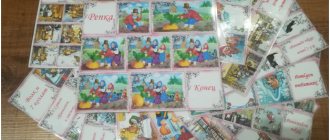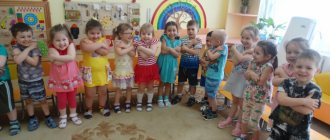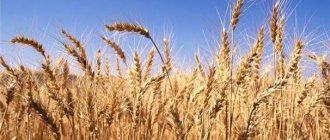Often parents are faced with the fact that children do not remember information well at school. Schoolchildren listen carefully only to what interests them, and ignore the rest. Memory acts selectively. Another problem that arises at school is the inability to retell a large text. As a result, academic performance decreases.
You can train your memory and teach children to retell texts on various topics even in preschool age. For this purpose, the material is presented in the form of reference diagrams, or mnemonic tables. You can start learning as early as two years old, when the child knows some fairy tales and tries to retell them, but confuses the characters and the sequence of events. Mnemonic tables for preschoolers are first compiled by an adult based on fairy tales known to the child.
The pictures in the cells are the heroes of fairy tales. The fairy tale “Kolobok” is very convenient in this situation, where events are repeated and the characters change. For the smallest children, mnemonic tables of four to nine cells are suitable. The adult and the child go through several mnemonic tables and analyze where the heroes of fairy tales hid. We draw the following mnemonic tables for preschoolers together with the child. Children quickly learn to make tables. Subsequently, the children themselves create tables for the information provided, complicating them and increasing the number of cells.
Progress of the lesson:
Voss: Guys, look how many guests came to us. Let's say hello to everyone.
Hello, our palms! (clap clap)
Hello, frisky legs! (top-top)
Hey tongues, wake up! (tsk)
Eyes, open ! (blink)
Hello, my friend, hello, my friend,
Let's bring our magic circle to life!
Give me your hand, and I'll give it to you,
And we will have fun!
Let us shout together to the whole wide world:
“Sun, hello! (wave to the sun.)
Hello guests!
(Waving to guests.)
”
Educator: Well done guys, we greeted each other. Now I’ll tell you a riddle and you try to guess it:
Nose - round
Small crochet ponytails
Three of them and what?
Friendly brothers look alike
Guess without a hint
Which fairy tale ? ( "Three piglets "
)
the piglets came to visit us
.-Tell me, guys, is the youngster a domestic or wild animal ? (children's answers)
- Why is the youngster a pet (lives next to a person)
.
Guys, we are currently celebrating “My Family”
, where we talk about our family, the family of animals.
Tell me, three little pigs are a family (Yes, because they are brothers)
Educator: And today we have an unusual activity, guys . You and I will learn to compose a fairy tale for our guests . Let's rest a little, and then remember the fairy tale about the three little pigs .
Piglet Piglet (Sitting, turn right, left, hands on your belt.
I rested myself in a barrel.
Got up on his feet, stretched, (Stand up, arms up and stretch.)
And then he sat down, bent over (Sit down, stand up, bend forward, straighten up.)
And he jumped a little, (Hands on the belt, jumping on two legs in place.)
And he walked on the spot. (Hands down, step in place.)
And then he lay down again,
But on the left side.
Educator: Well done, you had a rest, and now I invite you and our little guests to go on a fabulous journey .
Let's close our eyes and listen to the silence. Let's take a deep breath, exhale, inhale, exhale.
Educator: If a fairy tale comes knocking on the house ,
Let her in quickly.
Because a fairy tale is a bird ,
You scare it a little and it flies away.
Educator: Guys, do you like fairy tales ?
Wednesday, April 4, 2021
"Three piglets"
S. Mikhalkov fairy tale “The Three Little Pigs”
Genre: author's tale about animals
The main characters of the fairy tale “The Three Little Pigs” and their characteristics
What does the fairy tale “The Three Little Pigs” teach?
This fairy tale teaches us that it is better to work well once, but do a good thing, than to quickly do something that will break in an hour. It’s better to spend money once and buy something good than to buy something cheap that you’ll have to throw away in a week. This tale teaches forethought and thoroughness. Teaches you to correctly assess your capabilities and needs.
Review of the fairy tale “The Three Little Pigs”
I liked this fairy tale because its main idea is very reasonable. Not only a pig's house should be a fortress. Everything that surrounds us should be good and reliable. The piglets in the fairy tale were very different, and if Naf-Naf understood that the house should be good, then everything was done at random. If the wolf had not blown their houses away, they would have frozen in the winter.
Proverb for the fairy tale “The Three Little Pigs”
Labor feeds, but laziness spoils. Labor conquers everything. Haste does not help matters.
Summary, brief retelling of the fairy tale “The Three Little Pigs”
Once upon a time there were three little pigs who were having fun in the summer. But then autumn came and the most sensible of the piglets, Naf-Naf, suggested building a house because he was shivering all over from the cold. Nif-Nif and Nuf-Nuf refused and remained idle for a long time. But when ice began to cover the puddles, they nevertheless began construction. Nif-Nif, without hesitation, made a house out of straw, Nuf-Nuf decided to build a warmer house, and made it from branches and twigs. The piglets went to see what kind of house Naf-Naf was building and saw that he was kneading bricks and installing an oak door. Naf-Naf believed that the pig's house should be his fortress and protect him from the wolf. Nif-Nif and Nuf-Nuf laughed and began to sing songs about the wolf, and so loudly that they woke up the wolf. The ox decided to eat the piglets and opened his mouth. The piglets ran away. Nif-Nif was the first to run into his house, but the wolf blew three times and his straw house scattered. Nif-Nif ran to Nuf-Nuf's house. The piglets locked themselves in the house. First, the wolf put on sheep's clothing and pretended to be a sheep. But the piglets recognized the wolf when they opened the door and managed to slam it. Then the wolf blew three times and the house made of branches fell apart. The piglets rushed to Naf-Naf and he let them in and closed the door. The wolf decided that he would now eat all the piglets and began to blow, then shake the door, then scratch the walls, but the stone house stood dead. Then the wolf climbed onto the roof, deciding to get inside through the pipe. Naf-Naf heard the wolf and opened the lid on the pan with boiling water. The wolf fell into it, but as soon as he jumped up, he flew back through the pipe. And the piglets began to live together.
Drawings and illustrations for the fairy tale “The Three Little Pigs”
Source
Summary of educational activities for speech development in the senior group. Visiting the fairy tale “The Three Little Pigs”
Lesson on speech development with children of the senior group of preschool educational institutions.
Topic: “Visiting the fairy tale “The Three Little Pigs”” Topic: “Visiting the fairy tale “The Three Little Pigs”. Goal: To create a condition for activating the vocabulary based on adjectives and plurals in preschool children. Objectives: Educational:
To help consolidate children’s knowledge about the fairy tale “The Three Little Pigs” and enrich their vocabulary.
Developmental:
Develop speech activity, encourage children to engage in dialogue.
Educational:
Develop the ability to listen to each other and act together.
Auxiliary material: Theatrical houses, masks, table, dishes, pictures of clothes, a large box equipped with levers and devices. Preliminary work: Reading Russian folk tales; playing out the fairy tale “The Three Little Pigs” using a didactic game, solving riddles. Forms of work: Create a positive environment, set up children to work together and divide children into subgroups. Methods: Visual - Plot pictures based on a fairy tale. Verbal - Conversation. Practical – Phys. minute “Building a house” Game: Into the characters of the fairy tale “The Three Little Pigs” Vocabulary work: Selection of adjectives: “A chair made of wood - wooden”, “potato soup - potato”, “a glass made of glass - glass”.
Progress of educational activities
Children enter the hall, say hello, stand in a semicircle Educator: Good morning, guys. Let's smile at each other. And say hello! Educator: Guys, today we have a not quite ordinary lesson, a fabulous one. I invite you to take a trip to a fairyland. The teacher asks the question: How will we get there? Children's answers: On a rocket, on a plane, on a train, on a bus, on a flying saucer. Educator: I suggest you go on a trip in a “time machine.” Let's see if she's ready to take us to a fairyland. Hop into our “time machine” and let’s see if it will transport us! (The teacher and the children approach the “Time Machine” (a large box with different levers and devices)
. Guys, what words need to be said so that our “time machine” will take us to the magical land of fairy tales?
(in chorus)
“One, two, three, To visit a fairy tale, transport us! So we are transported to a fairyland to our fairy tale!
Alyonushka comes out. Alyonushka: Hello guys, I am the mistress of a magical land of fairy tales. There are many, many fairy tales in my country. Today we will visit one of them. Let's guess the riddle, and by the answer you will understand what kind of fairy tale it is. Riddle: A village in the middle of the forest_ Three brothers were building. The wolf watched with interest as they quarreled. He decided to eat them, but it didn’t work out_ Only in vain did he climb onto the roof. The wolf ate their legs carried away Singing his gray tail. Singing a song loudly Having fun…………. Children's answer: “The Three Little Pigs" Educator: That's right, this is the fairy tale “The Three Little Pigs". And today we will visit them. Alyonushka leads the children to the house: And at home What kind of houses did the piglets have? Game exercise “What kind of houses did the piglets have?” (children select adjectives: Nif has Nif made of straw, Nuf-Nuf made of branches, and Naf has Naf made of bricks and stones (strong, clean, cozy. ) Alyonushka: What materials are houses built from? (children's answers.) GAME “Which house” (with a ball)
.
House made of wood - wooden From brick - brick From stone - stone From concrete - concrete From clay - clay From cardboard - cardboard From ice - ice From straw - straw From panel - panel From plastic - plastic. Educator: I suggest you rest a little. Phys. minute “We are standing the house” One, two, three, four, five. (Children jump on the spot)
Let's build and play.
We are building a big, tall house. (They stand on their toes and stretch their arms up)
We install windows and build a roof.
(Show the window and the roof with your hands - close your hands)
What a beautiful house!
(They extend their arms forward with an indicative gesture)
We will live with you in it!
(Squat down) Alyonushka: Piglet Naf - Naf invited his brothers to his housewarming party, there were dishes on the table. Poll about dishes. There was soup poured into the bowls. What do you guys think the soup was made from? Game exercise “What soup is made from” From mushrooms - mushroom, From fish - fish, From vegetables - vegetable, From potatoes - potato, From beets - beetroot, From carrots - carrot. Educator: Guys, look at this plate, there is only one, but when there are many of them, then let’s say: many plates; One glass, and when there are many of them... many glasses; One spoon...many spoons; One table...many tables; One chair...many chairs. One door…..many doors. One window…..many windows. Alyonushka: The piglets ate soup. I decided to change clothes and go for a walk. Guys, who knows what clothes are made from? Game “What are the clothes made of ” (the teacher shows pictures, the child names what kind of clothes they are)
Linen trousers - linen trousers, a coat made of wool - a woolen coat, a dress made of chintz - chintz, a scarf made of silk - silk, a hat made of fur - fur.
Educator: Thank you Alyonushka, you told us a fairy tale. And now our guys will show how they can play the characters of this fairy tale. Three pigs and a wolf are chosen from among the children: Children stand in a circle. The teacher touches one of the children. Child: “Oh, you hit me on the back, so I’ll be the Wolf.” The wolf selects piglets from among the children: “Come on, we need to see if you will be a piglet with us” (the one who is touched becomes a piglet)
.
We choose another piglet. Child is the first pig: “I’ll spin around and stand up straight, so you can be the second pig.” We choose the third pig. The child is the second pig: “Come on, he’ll have to be a pig.” The Wolf child puts on a wolf mask, and the piglet children wear piglet masks on their heads. The piglets sit on the edge of the forest and sing a song: “We are not afraid of the wolf...” Imitating the voice of a wolf. Piglet (speaks in a menacing voice)
: “Aren’t you afraid?
Now, as soon as I blow it, your house will fall apart.” The piglets run away, and the wolf catches up with them (we play 3 times)
.
Alyonushka: Well done guys. Thank you for visiting me in a fairyland. And I give you this wonderful book of fairy tales. Well, now hit the road. Goodbye, guys. Educator: Thank you Alyonushka. But it's time for us to return to kindergarten. (Children get into the Time Machine)
.
- Let's say the magic words again: “One, two, three, take us to kindergarten!” So we returned to kindergarten. Summary Guys, let's remember. - Where have we been today? What did we do there? What games did we play? Guys, I really enjoyed traveling with you through a fairyland. We will visit different fairy tales with you. And now we’re going to look and read a new book.
We recommend watching:
Lesson on speech development and familiarization with the environment in the senior group. Summary of a lesson on speech development for children in the senior group. Topic: “How winter meets spring” Summary of a lesson on speech development for older preschoolers Summary of a lesson on speech development in the senior group for children with a stutter: Winter fun
Similar articles:
Summary of a lesson on speech development in the senior group. Retelling of a work of art. Ushinsky “Medicine”
Summary of a lesson on speech development in the senior group. Funny riddles
Lesson notes on speech development in the senior group
Lesson summary on the topic “Relationships in the family.” Senior group
Lesson on emotional development in the senior group



